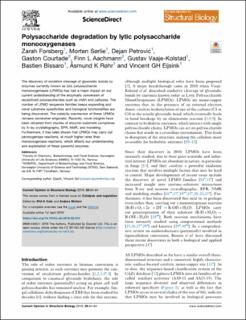| dc.contributor.author | Forsberg, Zarah | |
| dc.contributor.author | Sørlie, Morten | |
| dc.contributor.author | Petrovic, Dejan | |
| dc.contributor.author | Courtade, Gaston | |
| dc.contributor.author | Aachmann, Finn Lillelund | |
| dc.contributor.author | Vaaje-Kolstad, Gustav | |
| dc.contributor.author | Bissaro, Bastien | |
| dc.contributor.author | Kjendseth, Åsmund Røhr | |
| dc.contributor.author | Eijsink, Vincent | |
| dc.date.accessioned | 2020-11-09T15:31:17Z | |
| dc.date.available | 2020-11-09T15:31:17Z | |
| dc.date.created | 2019-05-31T16:36:26Z | |
| dc.date.issued | 2019 | |
| dc.identifier.citation | Current Opinion in Structural Biology. 2019, 59 54-64. | en_US |
| dc.identifier.issn | 0959-440X | |
| dc.identifier.uri | https://hdl.handle.net/11250/2686988 | |
| dc.description.abstract | The discovery of oxidative cleavage of glycosidic bonds by enzymes currently known as lytic polysaccharide monooxygenases (LPMOs) has had a major impact on our current understanding of the enzymatic conversion of recalcitrant polysaccharides such as chitin and cellulose. The number of LPMO sequence families keeps expanding and novel substrate specificities and biological functionalities are being discovered. The catalytic mechanism of these LPMOs remains somewhat enigmatic. Recently, novel insights have been obtained from studies of enzyme–substrate complexes by X-ray crystallography, EPR, NMR, and modeling. Furthermore, it has been shown that LPMOs may carry out peroxygenase reactions, at much higher rates than monooxygenase reactions, which affects our understanding and exploitation of these powerful enzymes. | en_US |
| dc.language.iso | eng | en_US |
| dc.rights | Attribution-NonCommercial-NoDerivatives 4.0 Internasjonal | * |
| dc.rights.uri | http://creativecommons.org/licenses/by-nc-nd/4.0/deed.no | * |
| dc.title | Polysaccharide degradation by lytic polysaccharide monooxygenases | en_US |
| dc.type | Peer reviewed | en_US |
| dc.type | Journal article | en_US |
| dc.description.version | publishedVersion | en_US |
| dc.source.pagenumber | 54-64 | en_US |
| dc.source.volume | 59 | en_US |
| dc.source.journal | Current Opinion in Structural Biology | en_US |
| dc.identifier.doi | 10.1016/j.sbi.2019.02.015 | |
| dc.identifier.cristin | 1701942 | |
| dc.relation.project | Norges forskningsråd: 247001 | en_US |
| dc.relation.project | Norges forskningsråd: 247730 | en_US |
| dc.relation.project | Norges forskningsråd: 243663 | en_US |
| dc.relation.project | Norges forskningsråd: 243950 | en_US |
| dc.relation.project | Norges forskningsråd: 257622 | en_US |
| dc.relation.project | Norges forskningsråd: 240967 | en_US |
| dc.relation.project | Norges forskningsråd: 256766 | en_US |
| dc.relation.project | Norges forskningsråd: 268002 | en_US |
| dc.relation.project | Norges forskningsråd: 262853 | en_US |
| dc.relation.project | Norges forskningsråd: 221576 | en_US |
| cristin.unitcode | 192,12,0,0 | |
| cristin.unitname | Kjemi, bioteknologi og matvitenskap | |
| cristin.ispublished | true | |
| cristin.fulltext | original | |
| cristin.qualitycode | 1 | |

